Disclaimer: This blog post contains affiliate links. If you make a purchase through these links, I may earn a small commission at no additional cost to you. Learn More. Thank you for supporting our garden community.
30 Yellow Flowering Herbs You Need to Grow in Your Garden
Last Updated: August 23, 2024
Have you ever wandered through a garden or meadow and found yourself captivated by the vibrant yellow blooms of the herbaceous plants around you? Beyond their beauty, these herbs with yellow flowers hold a treasure trove of benefits, ranging from medicinal properties to culinary uses. But how do you distinguish these golden gems from the vast array of greenery? This guide will illuminate the path to identifying, cultivating, and utilizing the most stunning and beneficial yellow-flowering herbs.
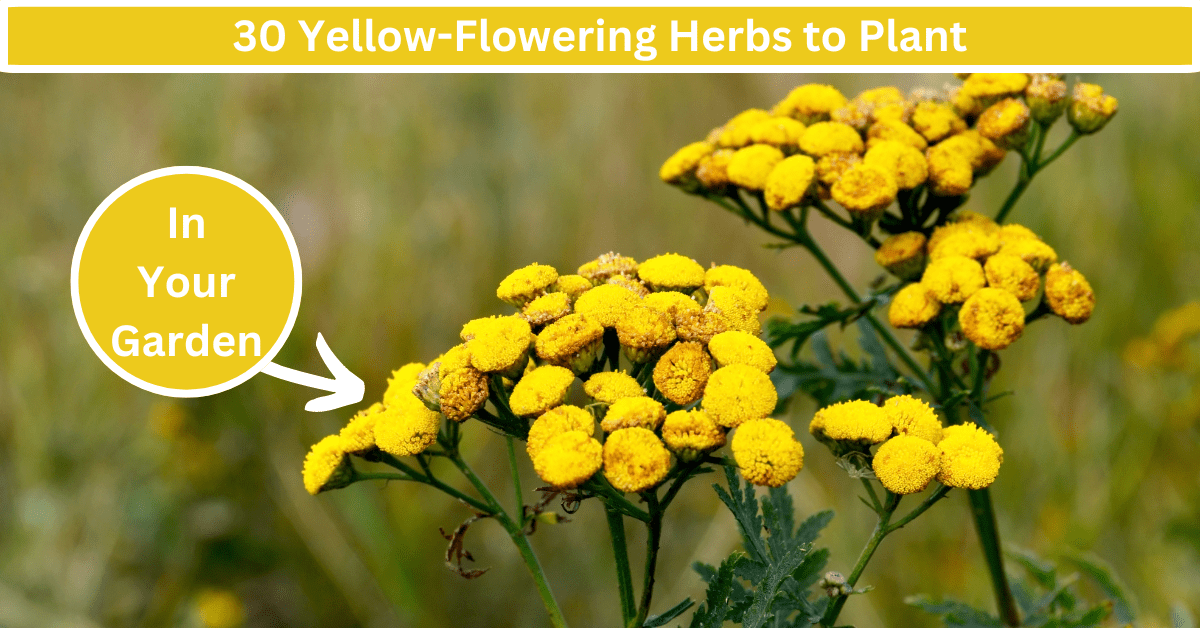
Diving into the world of yellow-flowered herbs, this article introduces you to 30 diverse plants that blend beauty with functionality.
As we explore each herb, we uncover the rich history and multifaceted benefits they bring to gardens, kitchens, and home remedies.
Whether you’re an avid gardener or an enthusiast of natural healing, get ready to be inspired by the unique qualities and applications of these radiant flowers.
Yellow Flowering Herbs You Need to Grow
Here’s what you’ll learn in this comprehensive article:
- Diversity of Yellow-Flowered Herbs: This article showcases a wide range of herbs, each with yellow flowers, demonstrating the diverse types available for various uses.
- Culinary and Medicinal Uses: For many of the listed herbs, this article briefly introduces their common uses, particularly highlighting those with significant culinary value or medicinal properties, thereby providing insights into how these plants can be utilized beyond their aesthetic appeal.
- Identification and Cultivation Information: By mentioning specific characteristics of the herbs, such as their flower types and plant form, you can gain preliminary knowledge on identifying these herbs and will find basic cultivation tips to help start or enrich your own gardens.
- Inspiration for Gardeners and Herbalists: Gardeners looking to add a splash of yellow to their landscape or herbalists interested in expanding their repertoire of medicinal plants will find this article inspiring, offering ideas for new plants to explore and integrate into their practices.
The Allure of Yellow Flowering Herbs
Yellow-flowering herbs are not just a feast for the eyes; they can also be powerhouses of health and flavor. From the soothing properties of Chamomile to the culinary delight of Dill, each herb brings its unique advantages to the table.

Cultivating Your Yellow Herb Garden
Creating a garden that boasts a variety of herbs with yellow flowers is easier than you think. Whether you have a sprawling backyard or a modest balcony, here’s how to start:
- Select Your Herbs: Consider factors like climate, soil type, and sunlight. Not all of these plants are necessarily able to grow in your climate, so choose the ones that will thrive in your area.
- Prepare the Soil: Ensure it is well-draining and nutrient-rich. Amend the soil with well-rotted compost or manure and consider adding an organic fertilizer for an extra kick. Make sure your soil is well draining by mixing in some Espoma Organic perlite.
- Planting: Follow specific spacing and depth instructions for each herb. When planting from seed or starters, the instructions are typically listed on the label. Each plant is different, so make sure they have the right environment to thrive.
- Maintenance: Regular watering, weeding, and harvesting will keep your herbs healthy.
Encouraging a Sustainable Ecosystem
Did you know that planting herbs with yellow flowers can attract essential pollinators to your garden? Discover the dual benefit of beautifying your space and supporting local wildlife.
At least 75% of the world’s flowering plants rely on pollinators to reproduce. That is insane.
But the problem is not this. The problem is that pollinators are declining at rapid rates, so it’s important to help them along their journey by planting these yellow flowering herbs in your garden.
When the pollinators die, so do 75% of the world’s flowering plants. Who on Earth wants that to happen?
The yellow flowers of these herbs are very attractive to pollinating insects, such as bees, butterflies, and wasps. They feed on the nectar inside, which helps them survive, which helps all those flowering plants survive.
30 Yellow Flowering Herbs You Need to Grow in Your Garden
Let’s not waste anymore time! Here are 30 yellow flowering herbs that you need to grow in your garden. Most selected varieties are available on SeedsNow or Nature Hills Nursery, so click on their name to purchase it!
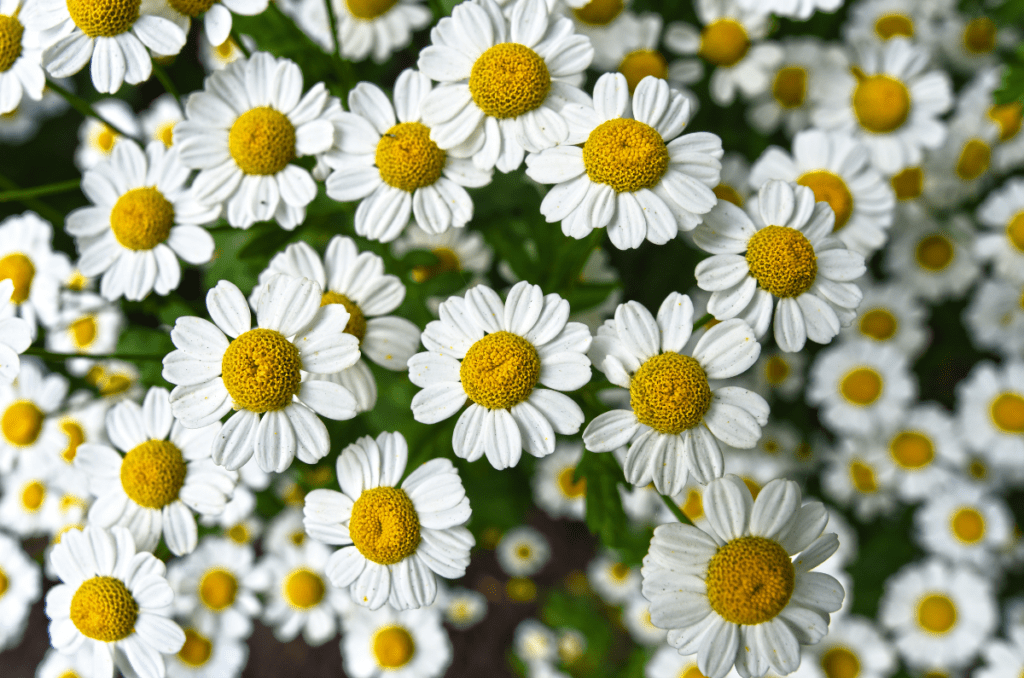
Chamomile
Chamomile is renowned for its delicate, daisy-like flowers and soothing properties. A staple in herbal teas, it aids in relaxation, promotes better sleep, and helps with digestion. Its gentle nature makes it a favorite for skincare formulations as well.
Chamomile is an annual plant that grows 2-3 feet tall is best planted in full sun to part shade.
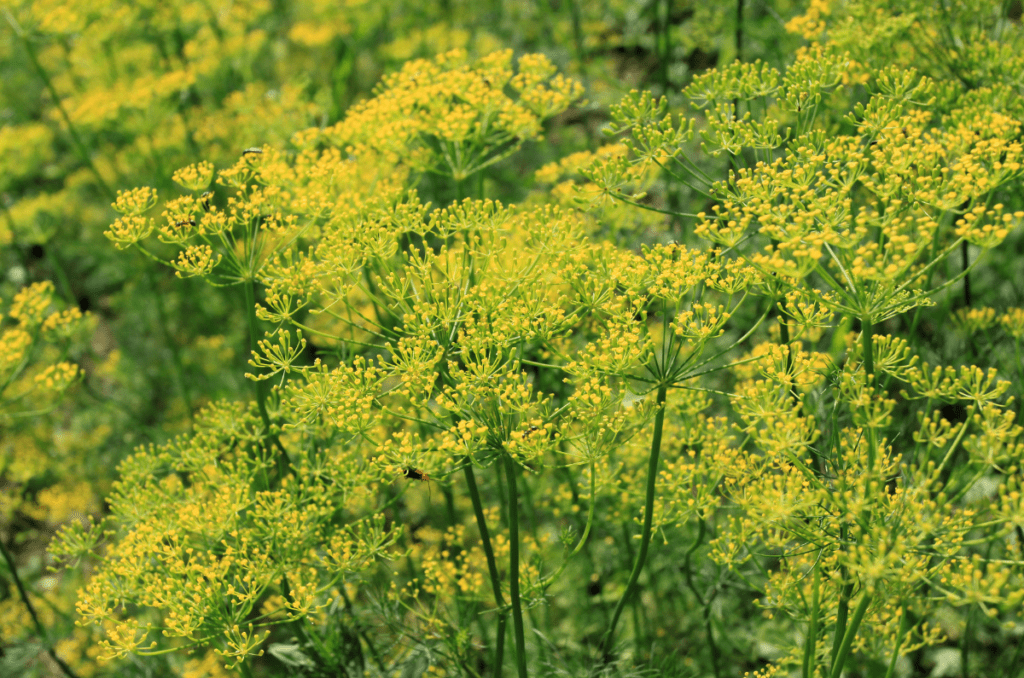
Dill
Dill is known for its feathery leaves and yellow flowers, imparting a sweet, grassy flavor with a hint of citrus. It enhances dishes like fish and sauces and offers digestive and anti-inflammatory benefits.
Dill is an annual herb that grows 2-5 feet tall and is best planted in full sun to part shade.
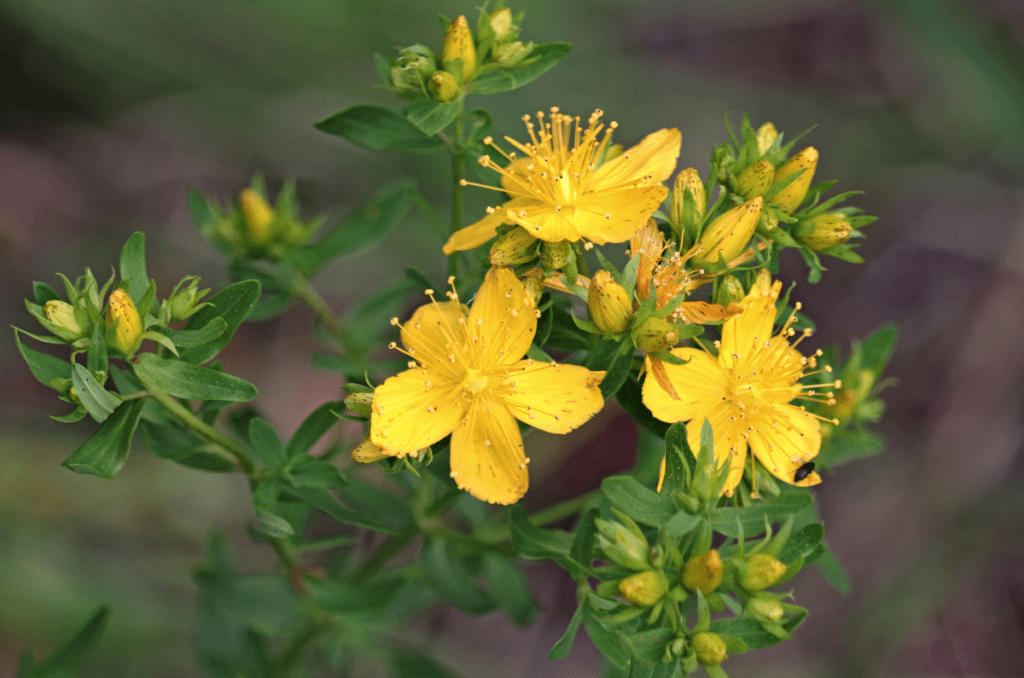
St. John’s Wort
Identified by its bright, star-shaped flowers, St. John’s Wort is celebrated for its mood-enhancing capabilities. It’s widely used in herbal remedies for depression, anxiety, and wound healing due to its anti-inflammatory properties.
St. John’s wort is a perennial shrub that grows 1-3 feet tall and is best planted in full sun or part shade.
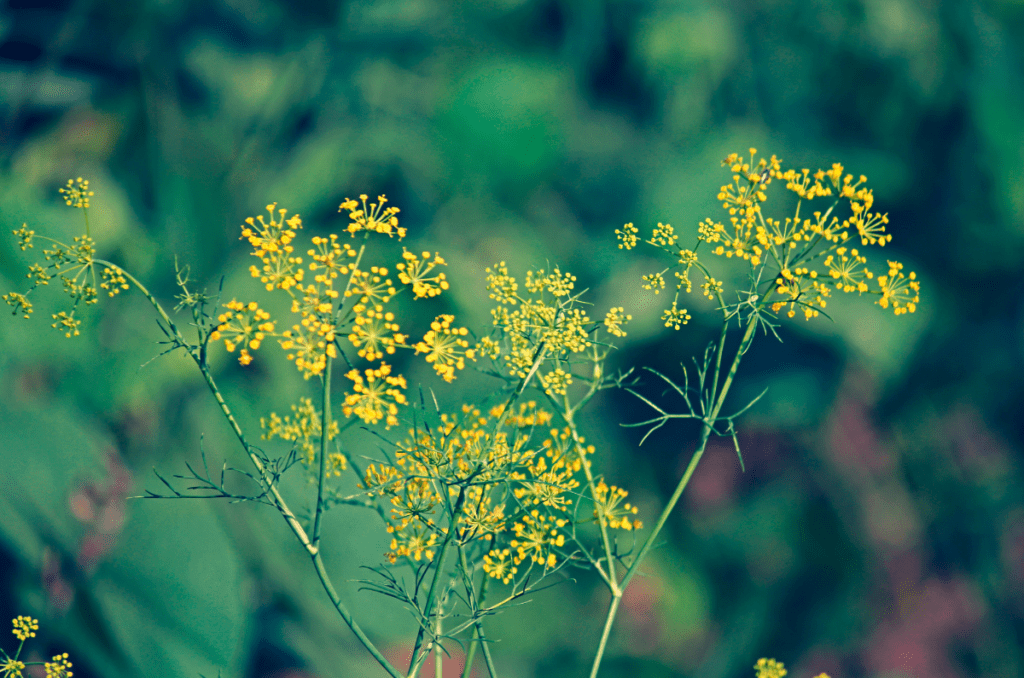
Fennel
Fennel is a versatile herb with feathery green leaves and yellow flowers. It’s known for its anise-flavored seeds and bulb, which improve digestion, alleviate gas, and even freshen breath.
While fennel is a perennial herb, it is typically grown as an annual. It can grow 4-5 feet tall and is best planted in full sun.
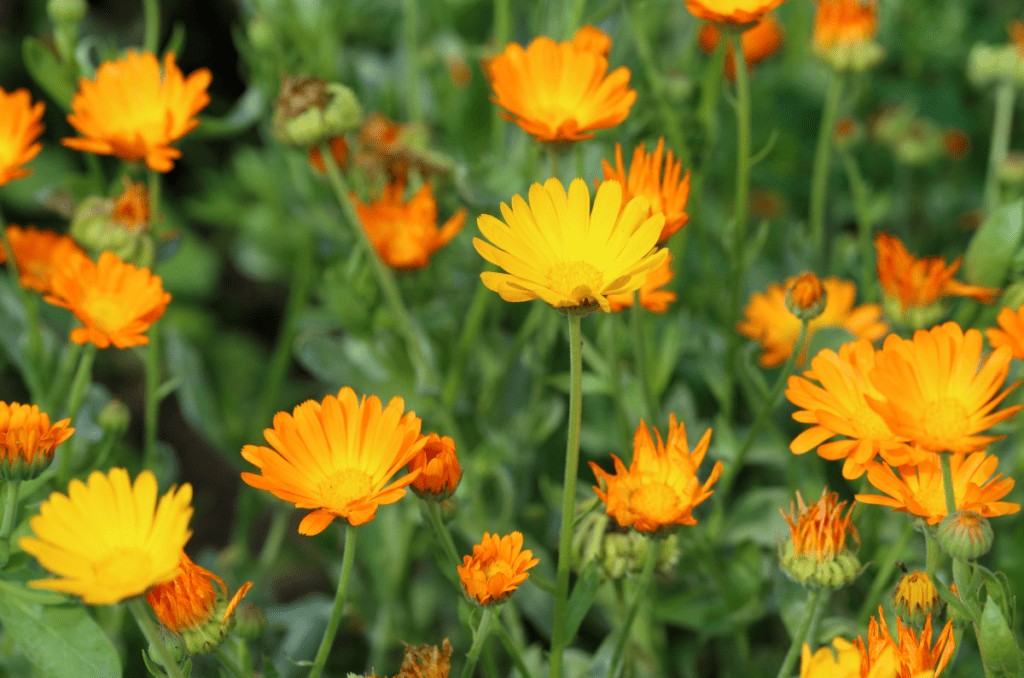
Calendula
Calendula, with its vivid golden blooms, is prized in herbal medicine for its ability to heal skin irritations, cuts, and burns. It’s also edible, adding a splash of color and a peppery taste to salads and dishes.
Calendula is an annual plant that grows 1-2 feet tall and is best planted in full sun or part shade.
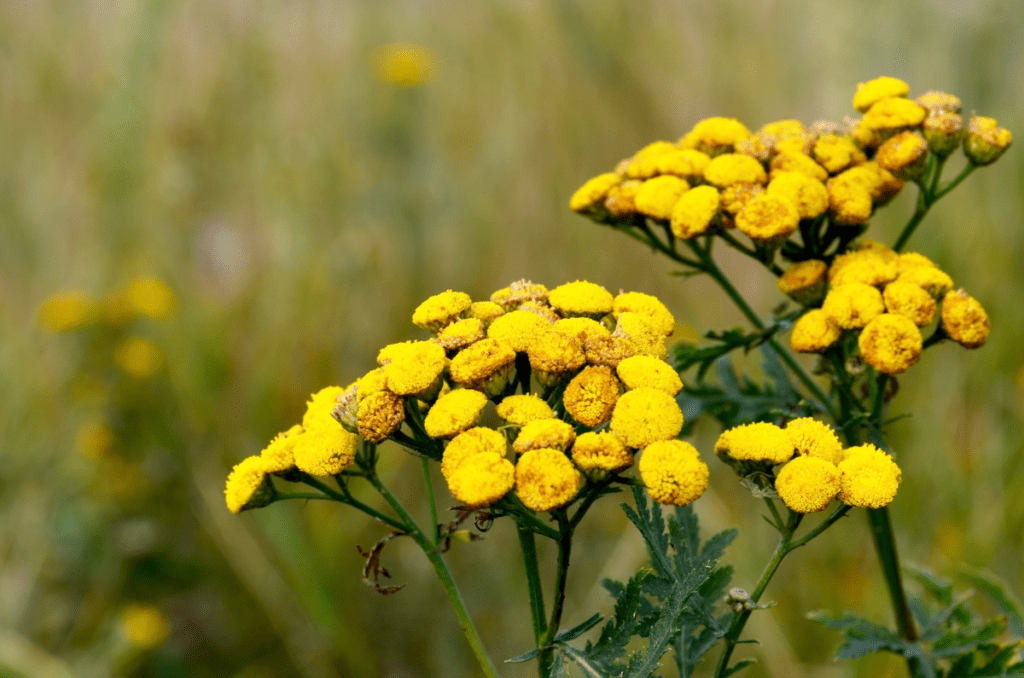
Tansy
Known for its button-like yellow flowers, tansy has a long history of use as a natural insect repellent and for intestinal parasite treatment, although caution is advised due to its toxic properties.
Tansy is a perennial that grows 2-5 feet tall and is best planted in full sun to part shade
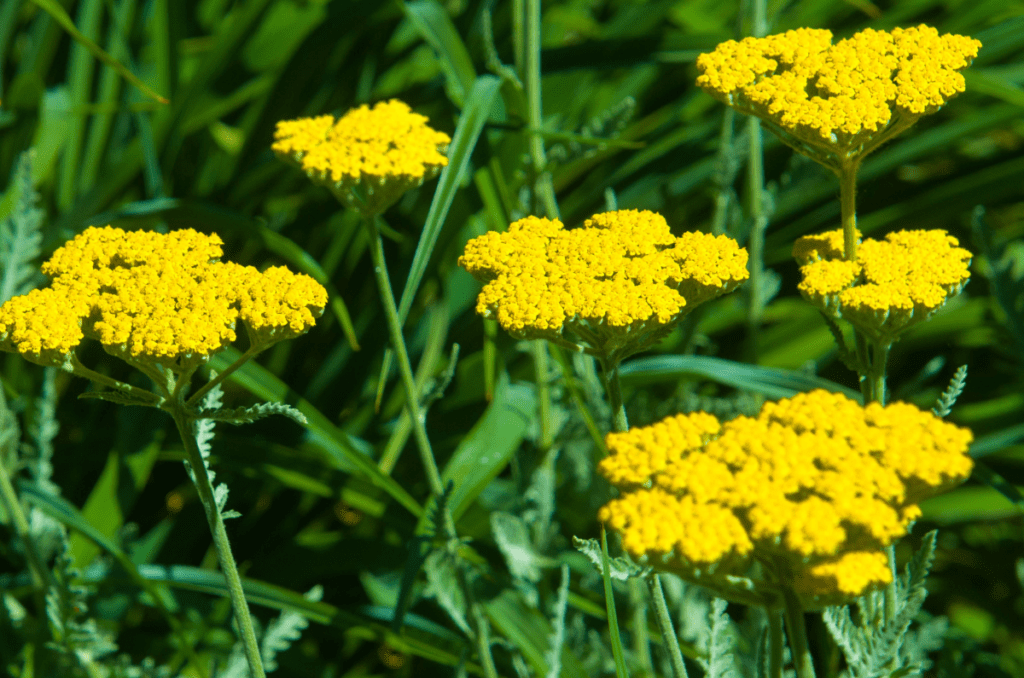
Yarrow
Yarrow, with its umbrella-shaped clusters of tiny yellow flowers, is a hardy herb known for its ability to stop bleeding, heal wounds, and reduce fever. It also attracts beneficial insects to gardens.
Yarrow is a perennial plant that grows 1-3 feet tall and is best planted in full sun.
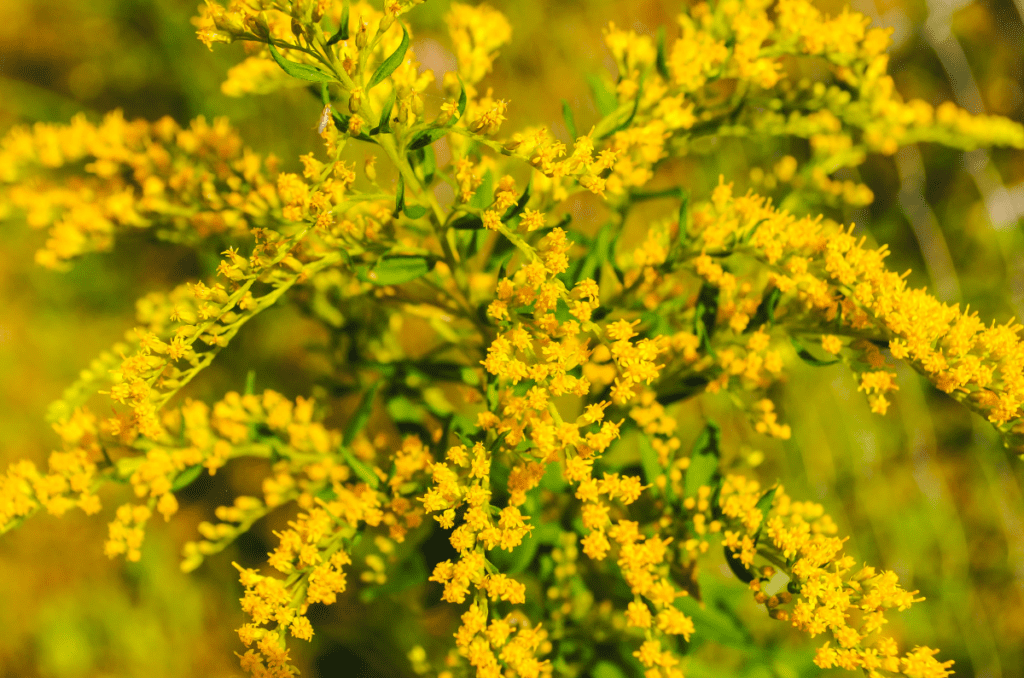
Goldenrod
Goldenrod sports clusters of tiny, bright yellow flowers that are favored by pollinators. Traditionally, it has been used for urinary tract support and as a remedy for allergies and inflammation.
Goldenrods are perennial plants that grows 2-5 feet (depending on the variety) and is best planted in full sun.
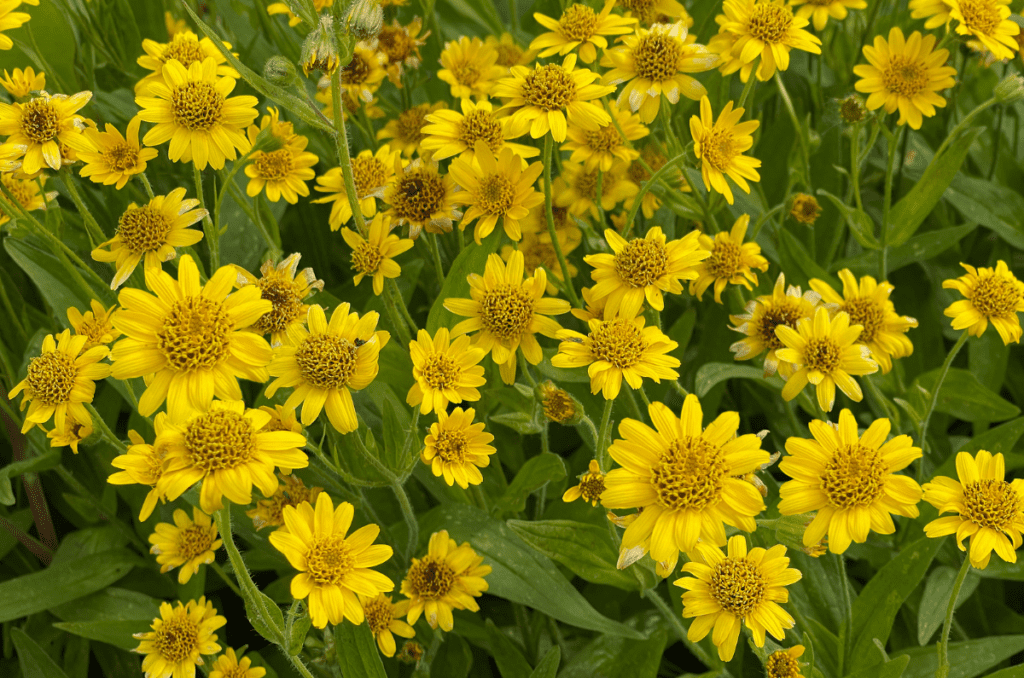
Arnica
This herb presents bright yellow, daisy-like flowers used primarily in topical preparations for bruises, sprains, and inflammation. Arnica is a staple in homeopathic remedies but is not recommended for internal use.
Arnica is a perennial plants that grows 1-2 feet tall and is best planted in full sun or part shade.
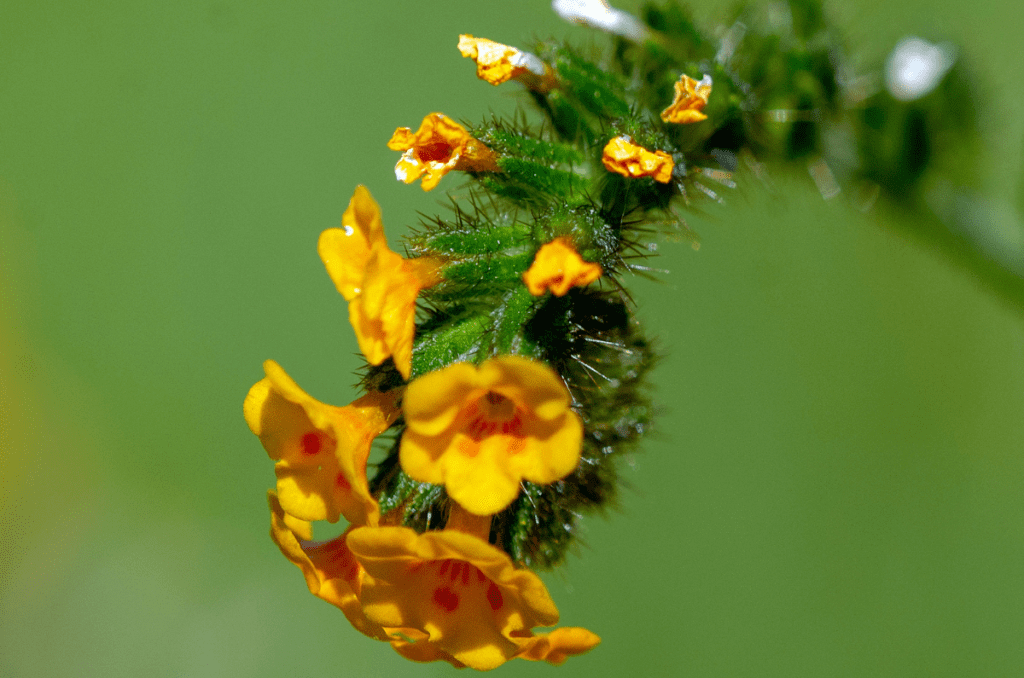
Borage
Borage typically produces star-shaped blue flowers, but some varieties can display yellow blooms. It’s used in salads for its cucumber-like taste and is reputed to uplift spirits and reduce fever.
The yellow-flowered borage in question is the common fiddleneck (borage family). It is an annual plant that grows 4 feet tall and is best planted in full sun.
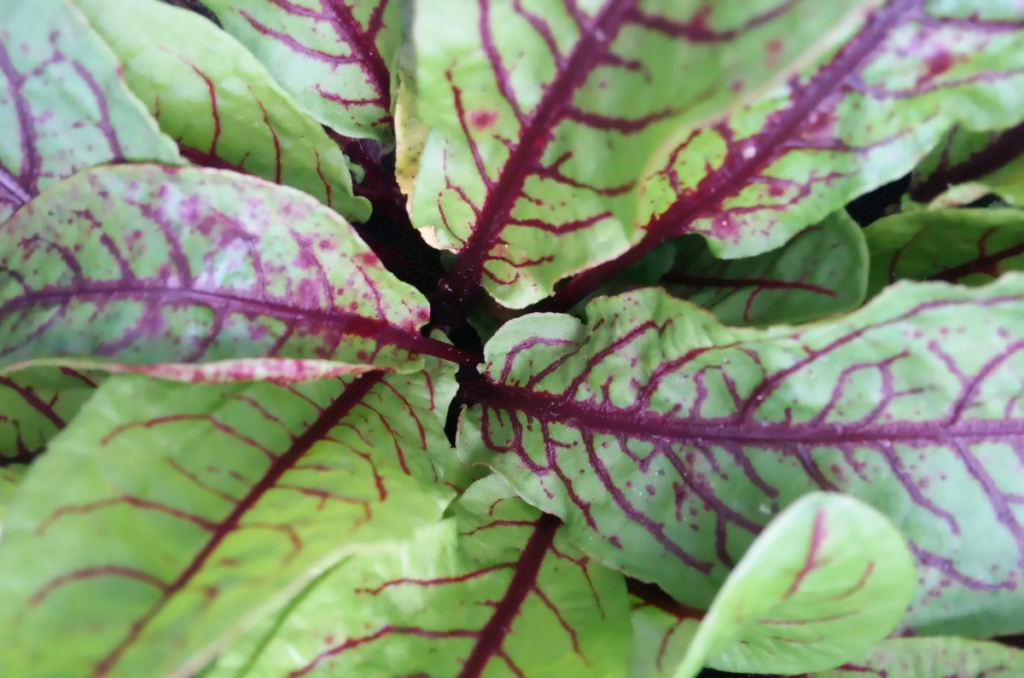
Sorrel
Sorrel is valued for its tart, lemony leaves, ideal for soups and sauces. It thrives in cooler climates and offers vitamin C and other nutrients.
Sorrel is a perennial herb that grows 1-2 feet tall and seems happy when planted in either full sun or part shade.
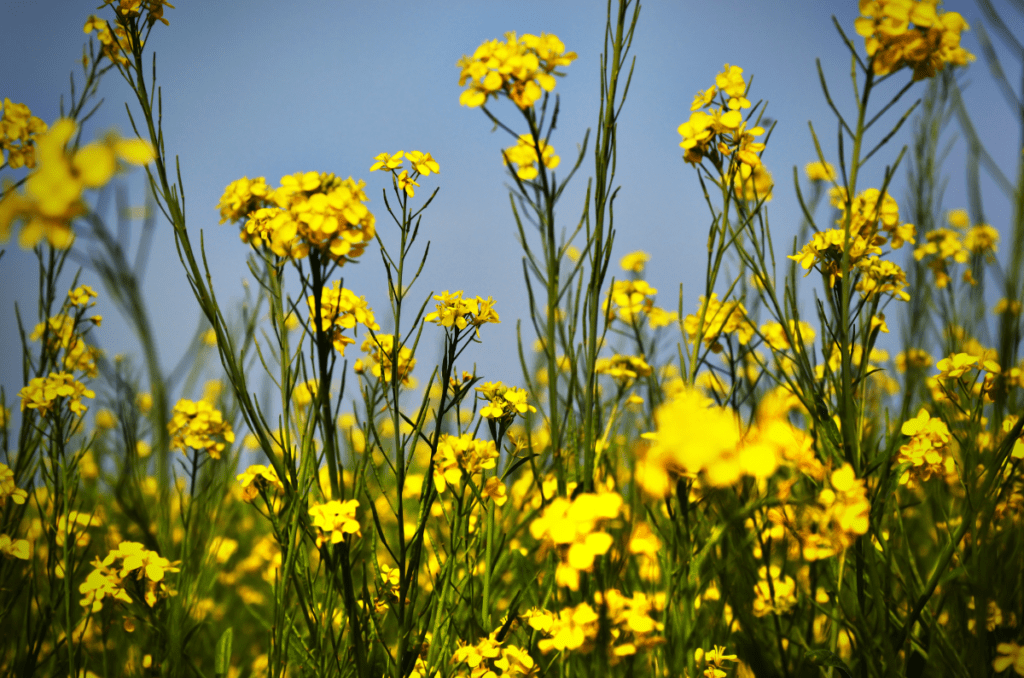
Mustard
The yellow flowers of mustard plants hint at the tangy seeds popular in culinary uses worldwide. Beyond its flavor, mustard greens have beneficial nutrients, and the seeds are used in poultices and baths for their warming properties.
Mustard is an annual plant that grows 2-3 feet tall and is best planted in full sun.
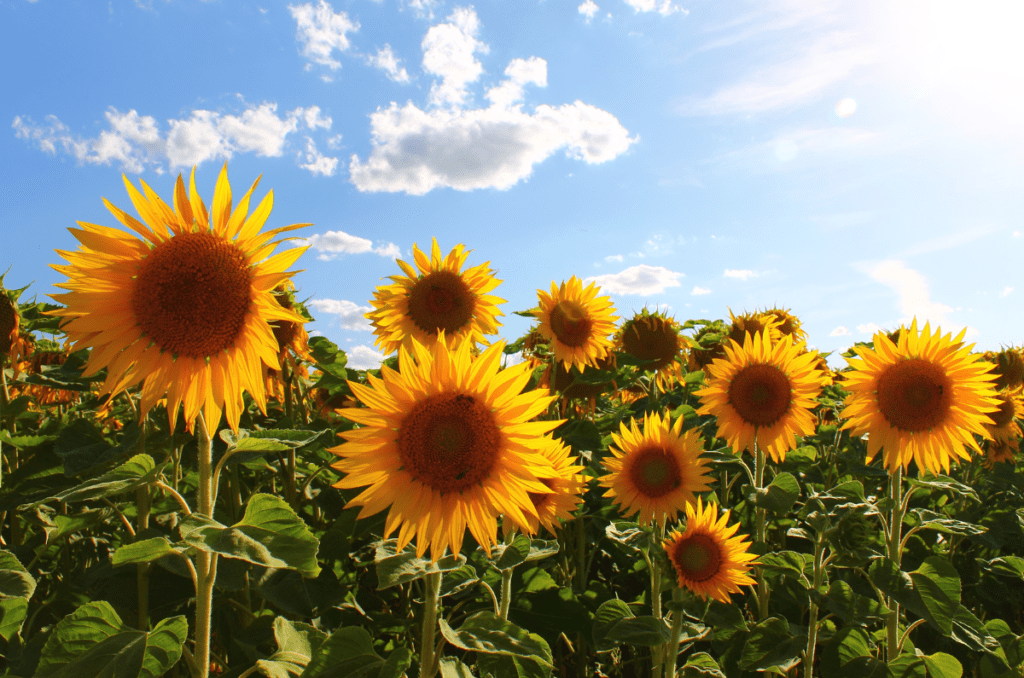
Sunflower
Sunflowers are iconic for their large, bright blooms that follow the sun. Their seeds are a nutritious snack, rich in healthy fats and proteins.
Sunflowers are annual plants. Most varieties grow 5-8 feet tall, while the tallest sunflower ever recorded was 30 feet tall!
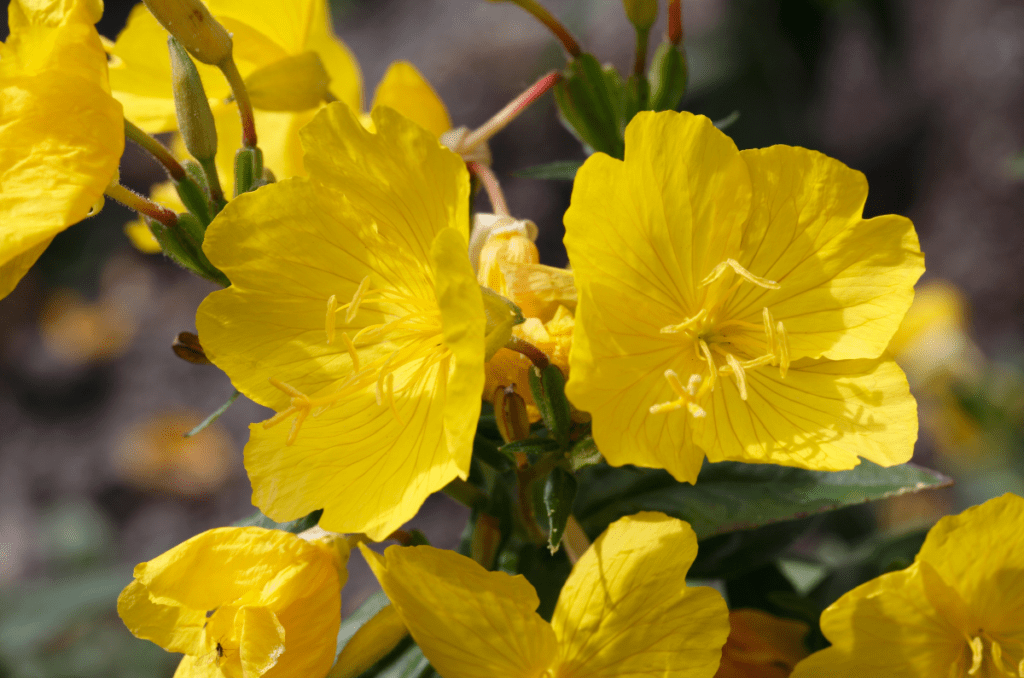
Evening Primrose
Evening primrose has striking yellow flowers that bloom in the evening. The plant’s seeds are a source of oil rich in gamma-linolenic acid, beneficial for skin conditions and hormonal balance.
Evening primrose is a perennial plant that grows 2-6 feet tall and is best planted in full sun or part shade.

Witch Hazel
This plant is celebrated for its yellow to red flowers and medicinal properties. Witch hazel extract is commonly applied topically for skin disorders and as a natural astringent.
Witch hazel is a shrub or small tree that can grow up to 30 feet tall and is best planted in full sun.
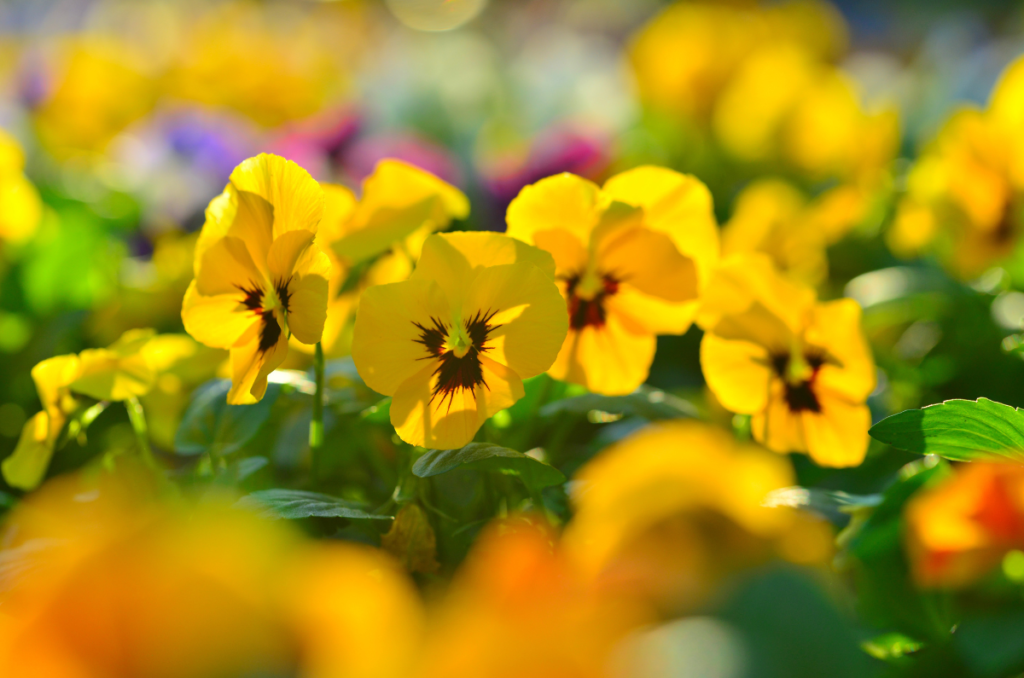
Pansy
Pansies are known for their wide, velvety flowers in various colors. Edible and decorative, they enrich gardens and culinary creations with a mild, grassy flavor.
Pansies are perennial plants that grow 4-9 feet tall and are best planted in full sun or part shade.

Safflower
Known for its bright yellow and orange flowers, safflower is cultivated for its seeds, which produce an oil used in cooking and in beauty products.
Safflower is an annual flower that grows 1-5 feet tall and is best planted in full sun.
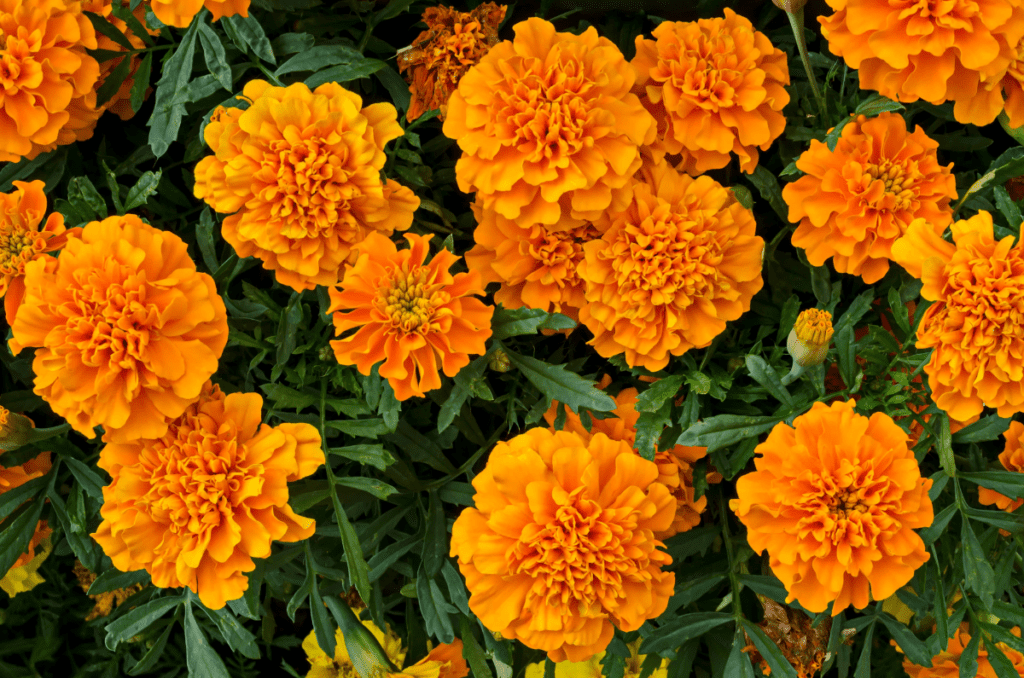
Marigold
Often found in gardens for their pest-repellent properties, marigolds have sunny, bright yellow or orange flowers. They’re used in traditional remedies for skin issues and as a coloring agent in foods.
Marigolds are annual plants that grow 1-2 feet tall and are best planted in full sun to part shade.
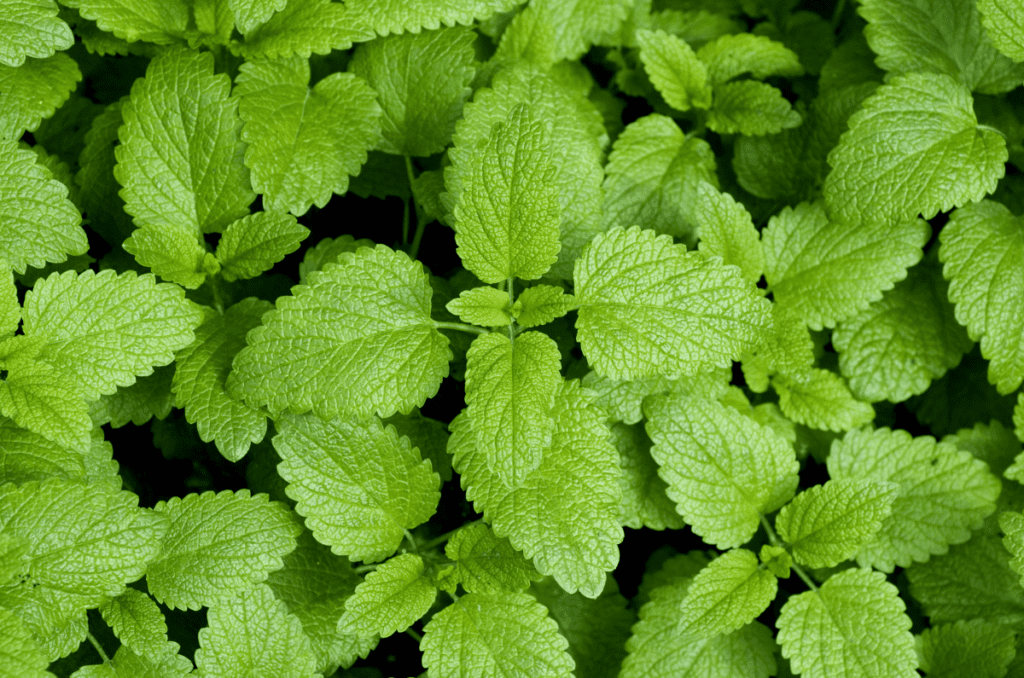
Lemon Balm
While not bearing yellow flowers, lemon balm has leaves that exude a lemony scent (so I thought lemon=yellow and I am going with it) and produce a subtle flavor used in teas. It is valued for its calming effects, helping to ease stress and aid sleep.
Lemon balm is a perennial herb that grows 2-3 feet tall and grows best in full sunlight.
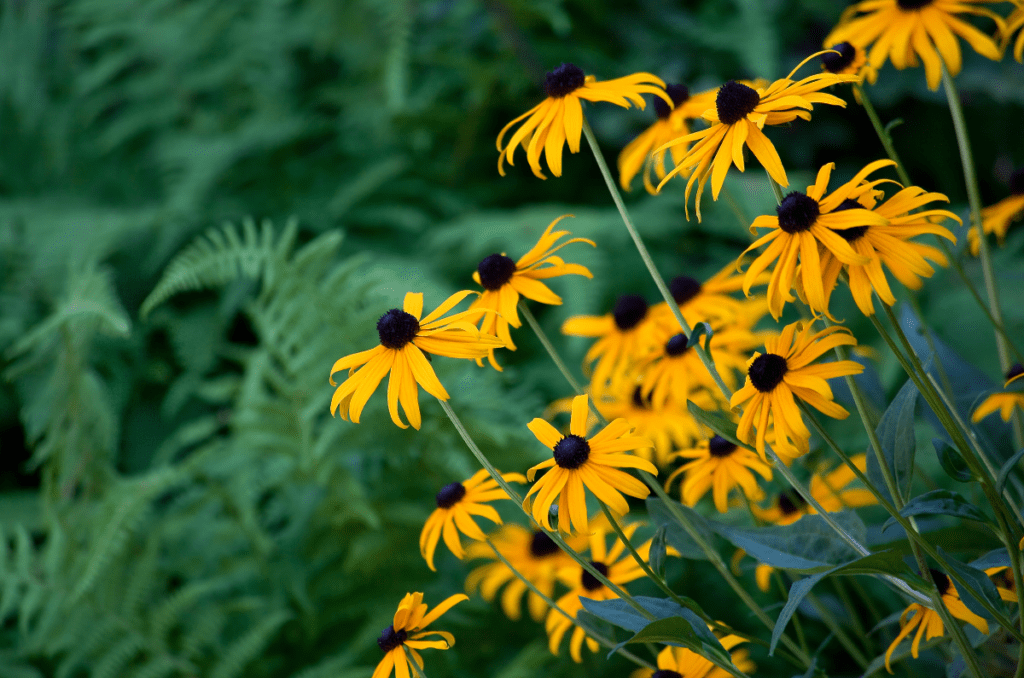
Black-eyed Susan
Not traditionally considered an herb, this North American native wildflower black-eyed Susan has medicinal uses similar to Echinacea, boosting immunity and fighting inflammation. Its cheerful flowers add beauty to any naturalistic garden setting.
Black-eyed susan is a perennial or biennial plant that grows 2-3 feet tall and is best planted in full sun.
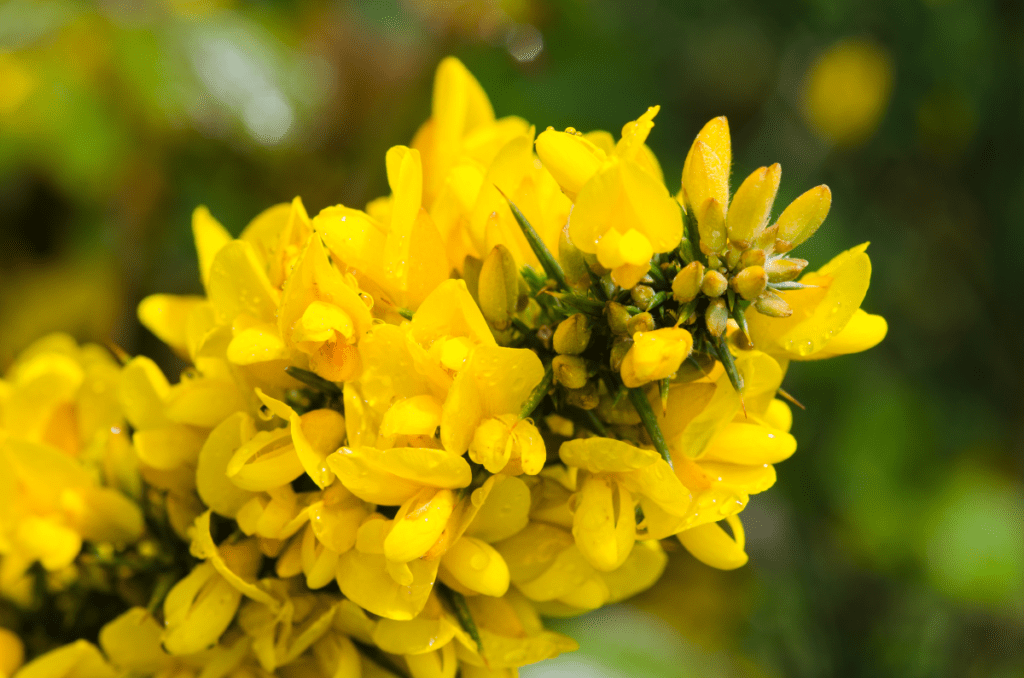
Gorse
Gorse is notable for its vibrant yellow flowers and spiny foliage, thriving in poor soils. It’s often used for hedging and its flowers can flavor gin and tea.
Gorse is a perennial shrub that grows 15 feet tall and is best planted in full sun.
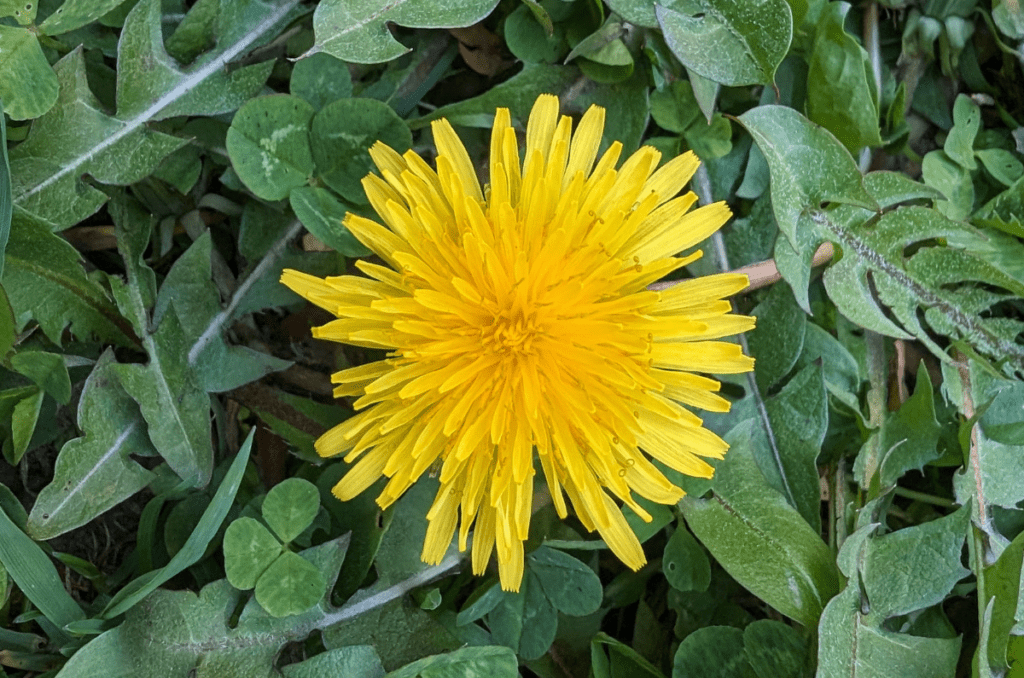
Dandelion
Often dismissed as a weed, the dandelion is a powerhouse of nutrition. Its yellow flowers, leaves, and roots are edible, supporting liver health, digestion, and featuring potent diuretic properties.
Dandelion is a perennial herb that grows 3-12 inches tall and is best planted full sun or part shade.
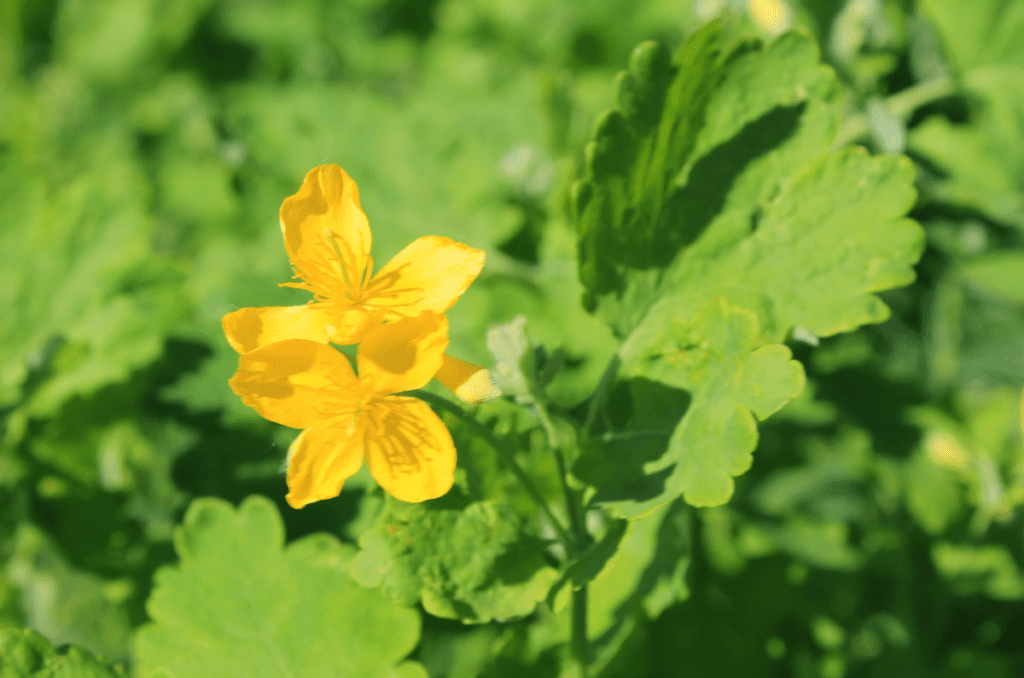
Celendine
Celandine features distinctive yellow flowers; it’s primarily used in traditional medicine to treat skin conditions due to its anti-inflammatory properties.
Celandine is a perennial herb that grows 1-2 feet tall and is best planted in full sun to full shade (the only full shade plant on this list).
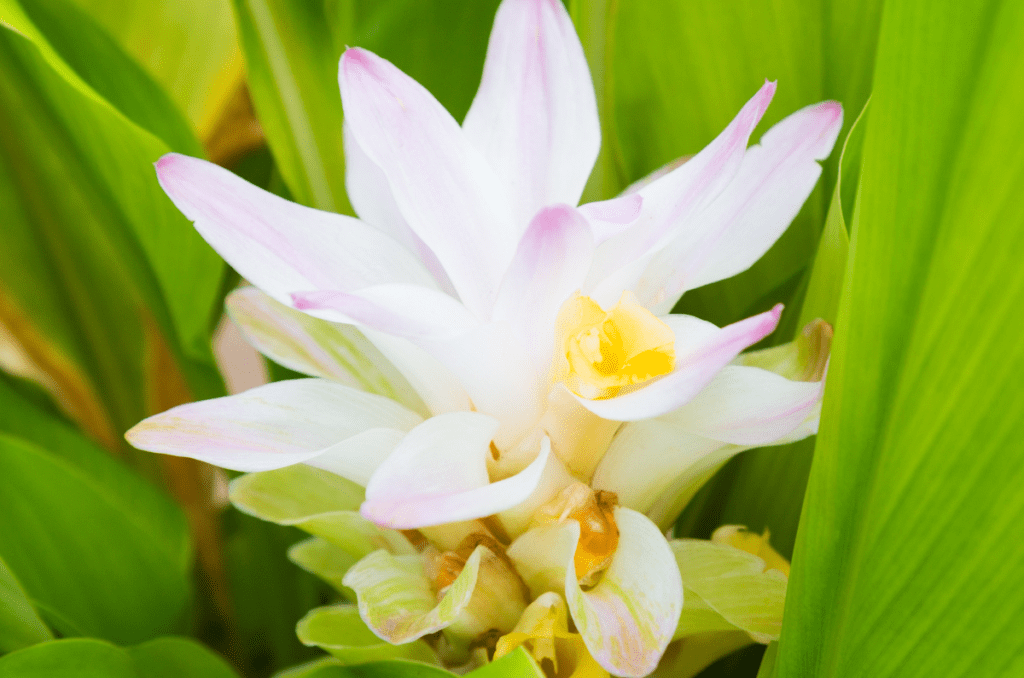
Turmeric
Turmeric is praised for its deep orange root, used as a spice and dye. It holds significant anti-inflammatory benefits and enhances numerous dishes with its warm, earthy flavor.
Turmeric is a perennial plant that grows 3-4 feet tall and is best planted in full sun.
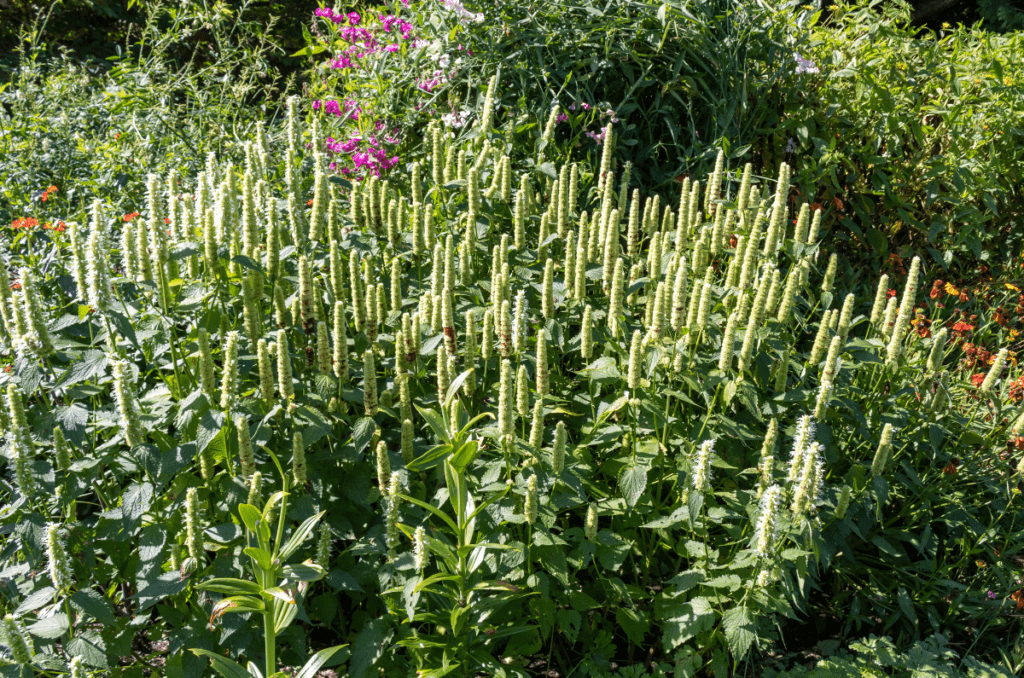
Hyssop
This herb, with its spikes of violet-blue or rarely yellow flowers, is a traditional respiratory remedy with antiviral properties, and it’s also used as a flavoring agent in liqueurs and foods.
Hyssop is a perennial herb that grows 1-3 feet tall and grows best in full sun to part shade.
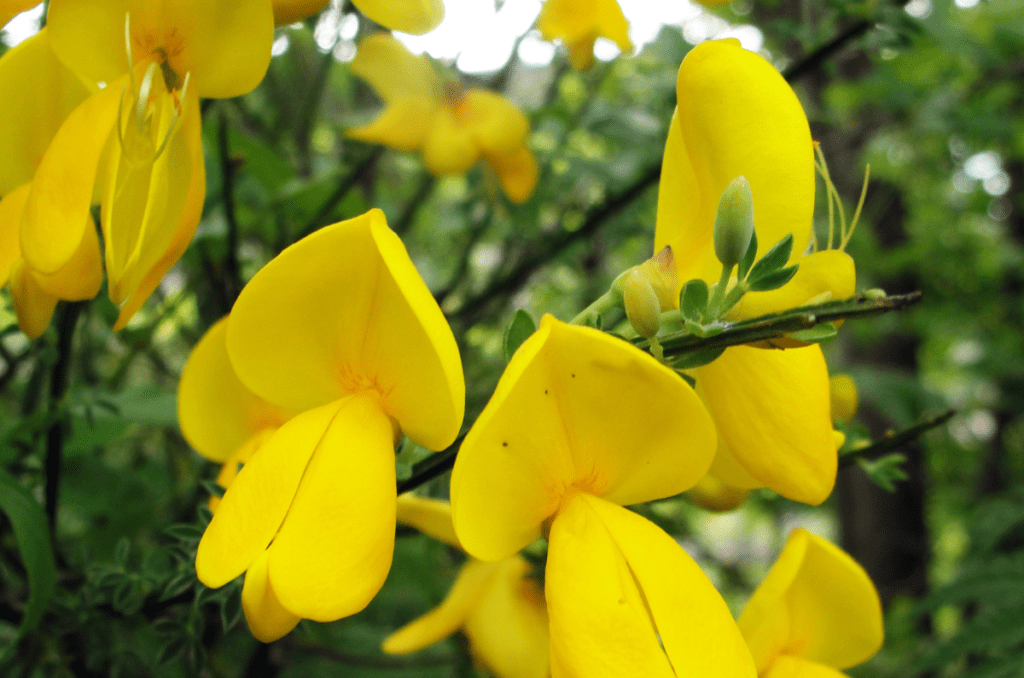
Sweet Peas
Celebrated for their fragrant, colorful blooms, sweet peas are primarily grown for ornamental purposes. They thrive in cool seasons and attract pollinators.
Sweet peas are climbing plants (similar to peas) that can grow 6 feet tall and are best planted in full sun in the cool seasons and part shade in the summer.
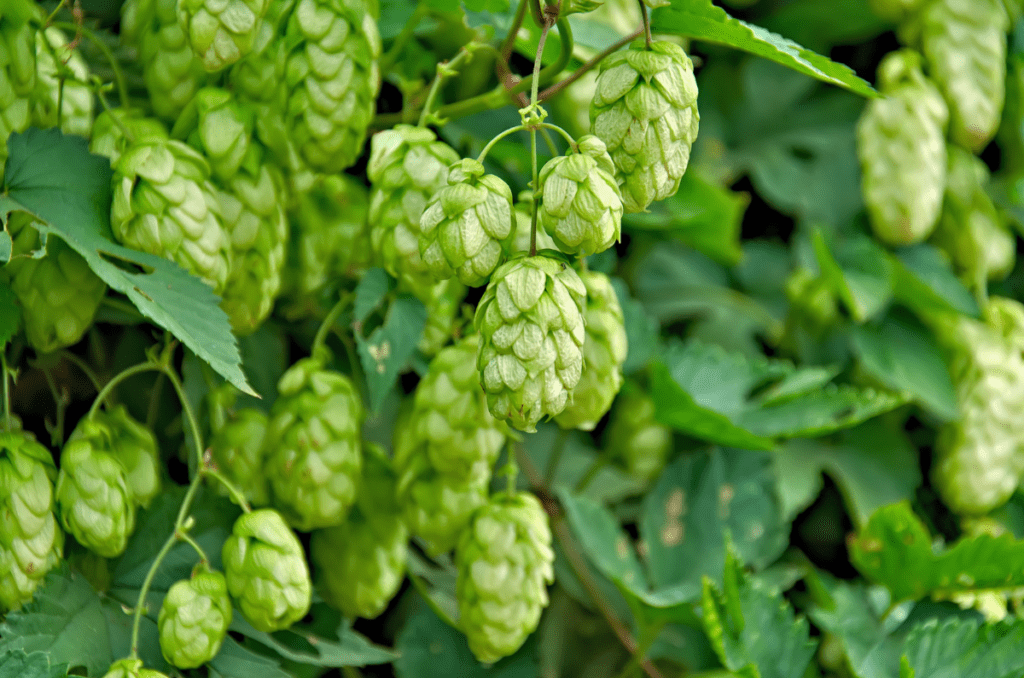
Hops
Essential in brewing, hops add bitterness and stability to beer. They also offer sedative qualities, traditionally used to improve sleep.
Hops are perennial climbing plants that grow 15-20 feet tall and are best grown in full sunlight.
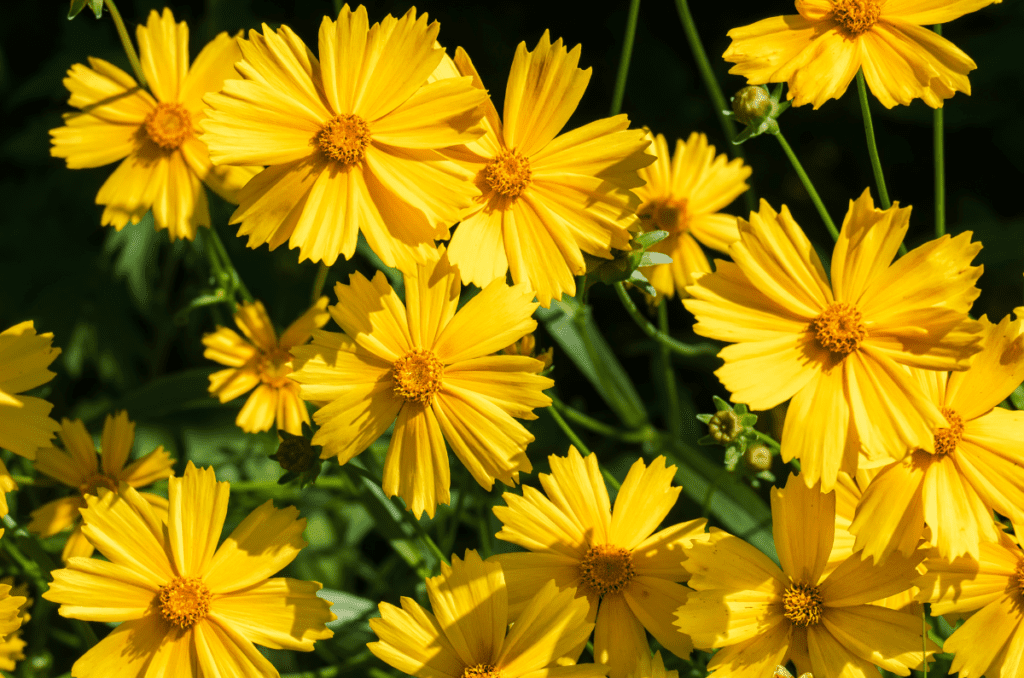
Coreopsis
Coreopsis, or tickseed, produces daisy-like flowers, brightening gardens with yellow, red, or orange blooms. They’re drought-tolerant and attract butterflies.
Coreopsis is a perennial plant that grows 1-4 feet tall and is best planted in full sun.
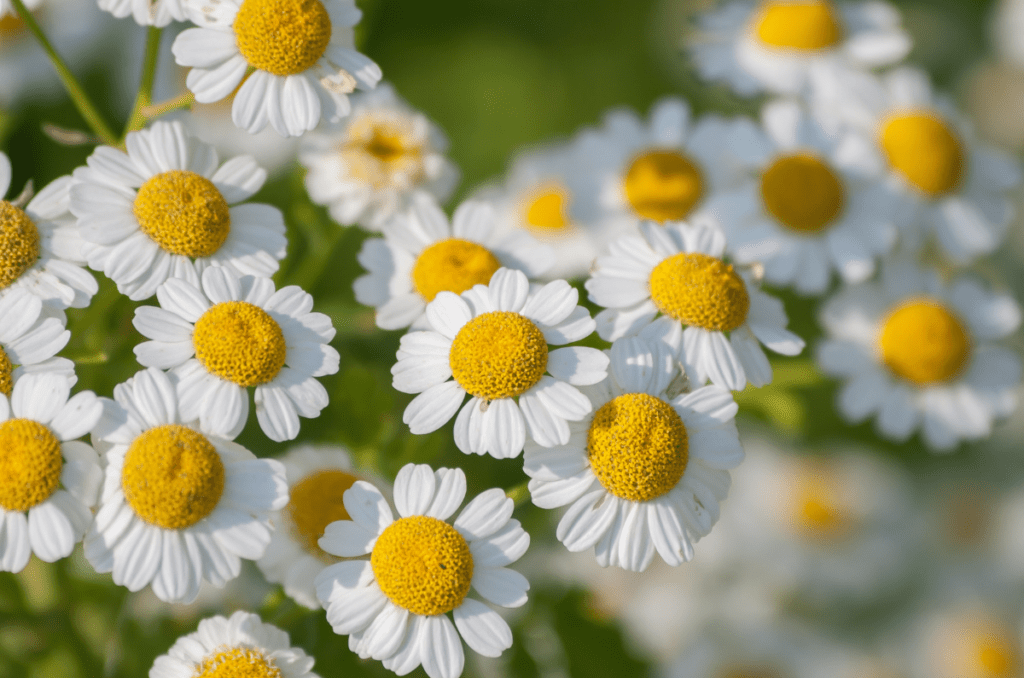
Feverfew
Feverfew is popular for its daisy-like flowers and its use in preventing migraines and headaches. It also has anti-inflammatory properties and has been traditionally used to reduce fever.
Feverfew is a perennial herb that grows 3-4 feet tall and is best planted in full sun to part shade
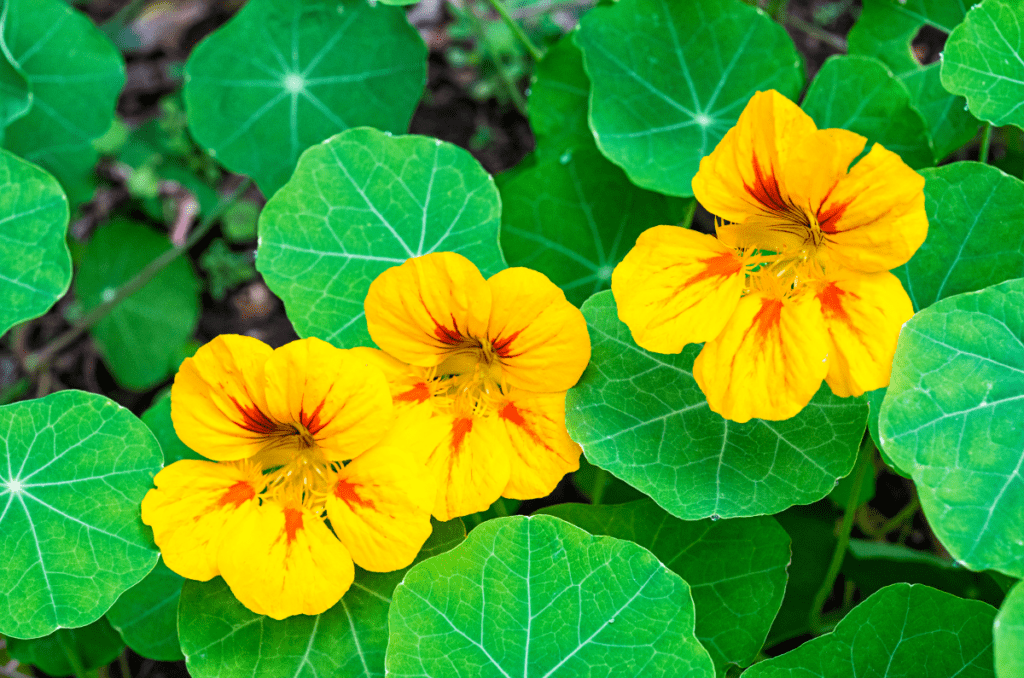
Nasturtium
Nasturtiums boast vibrant flowers and edible leaves, adding a peppery taste to salads. Known for their easy cultivation, they also have antibacterial properties.
Nasturtiums are annual plants that trail or climb and are best planted in full sun or part shade.
Each of these herbs brings its unique set of benefits, from the kitchen to the medicine cabinet, and contributes to the biodiversity and beauty of your garden.
Whether you’re looking to craft the perfect herbal tea blend or simply want to enjoy the visual appeal of these sunny blooms, there’s no shortage of yellow-flowered herbs to suit your needs.
Culinary Adventures With Yellow Flowered Herbs
Don’t just grow them—eat them! Learn how to incorporate herbs like Dill and Calendula into your cooking for a burst of flavor and color.
- Herb-Infused Oils: A simple way to infuse the essence of herbs into your dishes. Check out this recipe by Foodal.com
- Salads and Garnishes: Freshen up your plate with the vibrant hues and flavors of yellow flowers. Learn more from Food Garden Life.com
Discussion Questions:
- Have you grown any herbs with yellow flowers in your garden? What was your experience like?
- Are there any yellow-flowered herbs you’re curious about or have found particularly beneficial?
Please let us know in the comment section!
Frequently Asked Questions
Many yellow flowering herbs produce edible blooms. Nasturtium and sunflower seeds are popular in culinary uses, while others like gorse can be used as a flavoring.
Yes, several yellow flowering herbs have medicinal properties. Turmeric is known for its anti-inflammatory effects, while celandine has been used traditionally for skin issues.
This varies by herb, but many yellow flowering herbs are best planted in the spring after the last frost for optimal growth and flowering.
Yes, yellow flowering herbs like coreopsis and gorse are excellent for adding bright color and texture to gardens and landscapes.
Even More Gardening Ideas
Here are a few more posts to get the ball rolling in your garden!
- 10 Most Fragrant Flowers for Your Garden
- 10 Best Flowers for Raised Garden Beds
- 24 Flowers to Plant in August for Blooms All Season
Products
For all-purpose organic fertilizers, check out Fishnure.
To buy organic, non-GMO lavender seeds, check out SeedsNow.
For a wide selection of perennial garden plants, check out Nature Hills Nursery.
For gardening equipment, check out Bootstrap Farmer
Conclusion
Embarking on a journey with herbs that have yellow flowers opens up a world of health, culinary delight, and ecological benefits. Whether you’re a seasoned gardener or a curious novice, there’s never been a better time to explore the vibrant world of yellow-flowered herbs.
Don’t keep your experiences to yourself! Share your stories, tips, or questions in the comments below and let’s cultivate a community of yellow-flowered herb enthusiasts. For more green thumb guides and gardening wisdom, sign up for our newsletter and join a growing community of plant lovers.
If you want to learn more about gardening, foraging, nature, and sustainability, check out The Real Gardener on Instagram, YouTube, and Pinterest.
Pin this post for later:
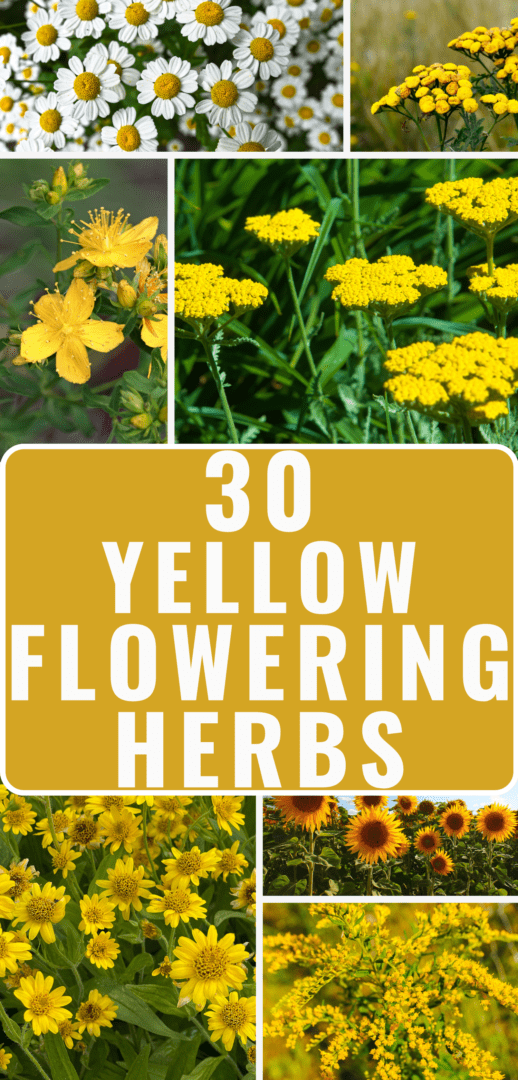
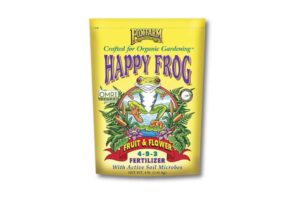
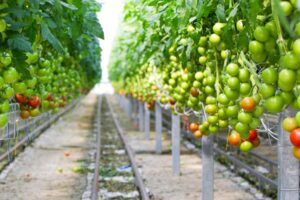
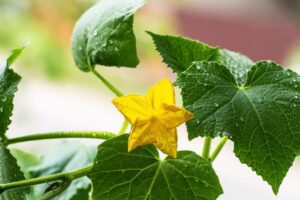
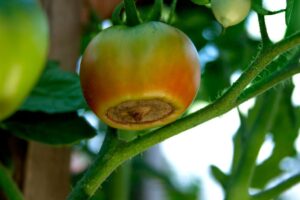
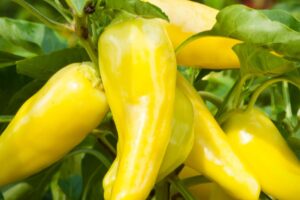
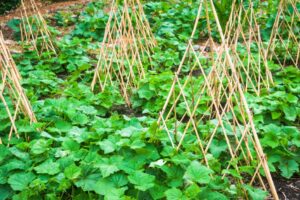
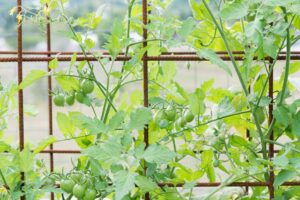
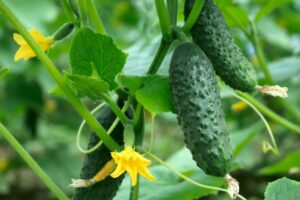
Some of these I didn’t even know had yellow flowers!
I feel that most people are surprised by yarrow and turmeric.
Amazing, hard to believe there are so many yellow flowering herbs.
Thank you for popping over and for participating and sharing at SSPS 325. See you again next week at #326 https://esmesalon.com/tag/seniorsalonpitstop/
Thanks Esme!